Principles of Ethics, CSR, and Change Agents in Organisations
VerifiedAdded on 2023/06/05
|11
|3022
|400
Essay
AI Summary
This essay provides a comprehensive analysis of organisational change, emphasizing the critical roles of ethics and corporate social responsibility (CSR). It explores how ethical considerations influence decision-making during organisational transformations, highlighting the importance of openness, employee participation, and the application of models like Kurt Lewin's approach to change. The essay also examines the significance of CSR, using Carroll’s four-part pyramid model to illustrate how businesses should integrate societal expectations into their operations. Furthermore, the role of change agents, particularly transformational leaders, is discussed, emphasizing their ability to inspire innovation and facilitate change through effective communication and continuous learning. The essay reflects on the relevance of various change management models, particularly Lewin's 3-stage model (unfreezing, changing, refreezing), in understanding and implementing successful organisational change.
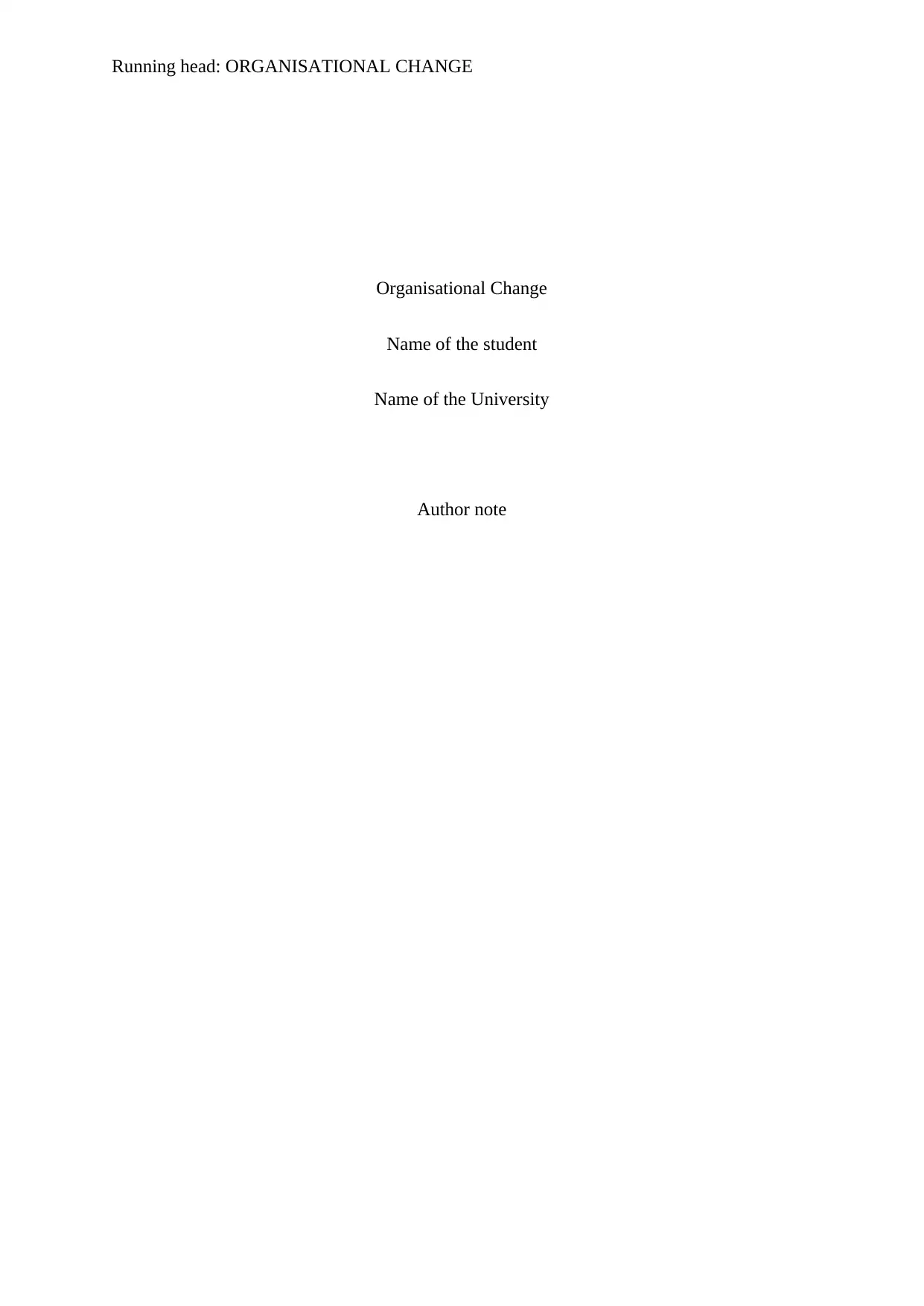
Running head: ORGANISATIONAL CHANGE
Organisational Change
Name of the student
Name of the University
Author note
Organisational Change
Name of the student
Name of the University
Author note
Paraphrase This Document
Need a fresh take? Get an instant paraphrase of this document with our AI Paraphraser
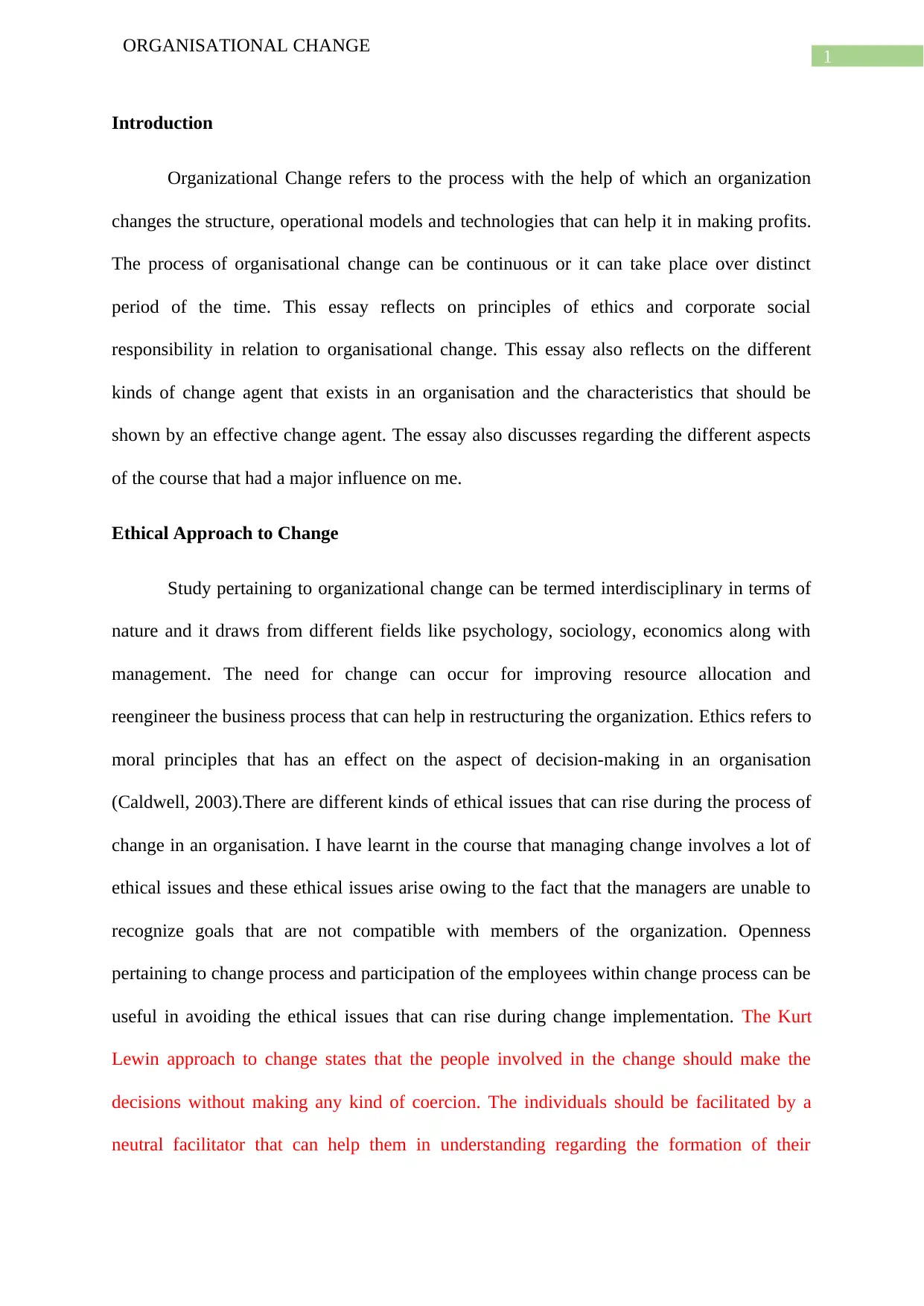
1
ORGANISATIONAL CHANGE
Introduction
Organizational Change refers to the process with the help of which an organization
changes the structure, operational models and technologies that can help it in making profits.
The process of organisational change can be continuous or it can take place over distinct
period of the time. This essay reflects on principles of ethics and corporate social
responsibility in relation to organisational change. This essay also reflects on the different
kinds of change agent that exists in an organisation and the characteristics that should be
shown by an effective change agent. The essay also discusses regarding the different aspects
of the course that had a major influence on me.
Ethical Approach to Change
Study pertaining to organizational change can be termed interdisciplinary in terms of
nature and it draws from different fields like psychology, sociology, economics along with
management. The need for change can occur for improving resource allocation and
reengineer the business process that can help in restructuring the organization. Ethics refers to
moral principles that has an effect on the aspect of decision-making in an organisation
(Caldwell, 2003).There are different kinds of ethical issues that can rise during the process of
change in an organisation. I have learnt in the course that managing change involves a lot of
ethical issues and these ethical issues arise owing to the fact that the managers are unable to
recognize goals that are not compatible with members of the organization. Openness
pertaining to change process and participation of the employees within change process can be
useful in avoiding the ethical issues that can rise during change implementation. The Kurt
Lewin approach to change states that the people involved in the change should make the
decisions without making any kind of coercion. The individuals should be facilitated by a
neutral facilitator that can help them in understanding regarding the formation of their
ORGANISATIONAL CHANGE
Introduction
Organizational Change refers to the process with the help of which an organization
changes the structure, operational models and technologies that can help it in making profits.
The process of organisational change can be continuous or it can take place over distinct
period of the time. This essay reflects on principles of ethics and corporate social
responsibility in relation to organisational change. This essay also reflects on the different
kinds of change agent that exists in an organisation and the characteristics that should be
shown by an effective change agent. The essay also discusses regarding the different aspects
of the course that had a major influence on me.
Ethical Approach to Change
Study pertaining to organizational change can be termed interdisciplinary in terms of
nature and it draws from different fields like psychology, sociology, economics along with
management. The need for change can occur for improving resource allocation and
reengineer the business process that can help in restructuring the organization. Ethics refers to
moral principles that has an effect on the aspect of decision-making in an organisation
(Caldwell, 2003).There are different kinds of ethical issues that can rise during the process of
change in an organisation. I have learnt in the course that managing change involves a lot of
ethical issues and these ethical issues arise owing to the fact that the managers are unable to
recognize goals that are not compatible with members of the organization. Openness
pertaining to change process and participation of the employees within change process can be
useful in avoiding the ethical issues that can rise during change implementation. The Kurt
Lewin approach to change states that the people involved in the change should make the
decisions without making any kind of coercion. The individuals should be facilitated by a
neutral facilitator that can help them in understanding regarding the formation of their
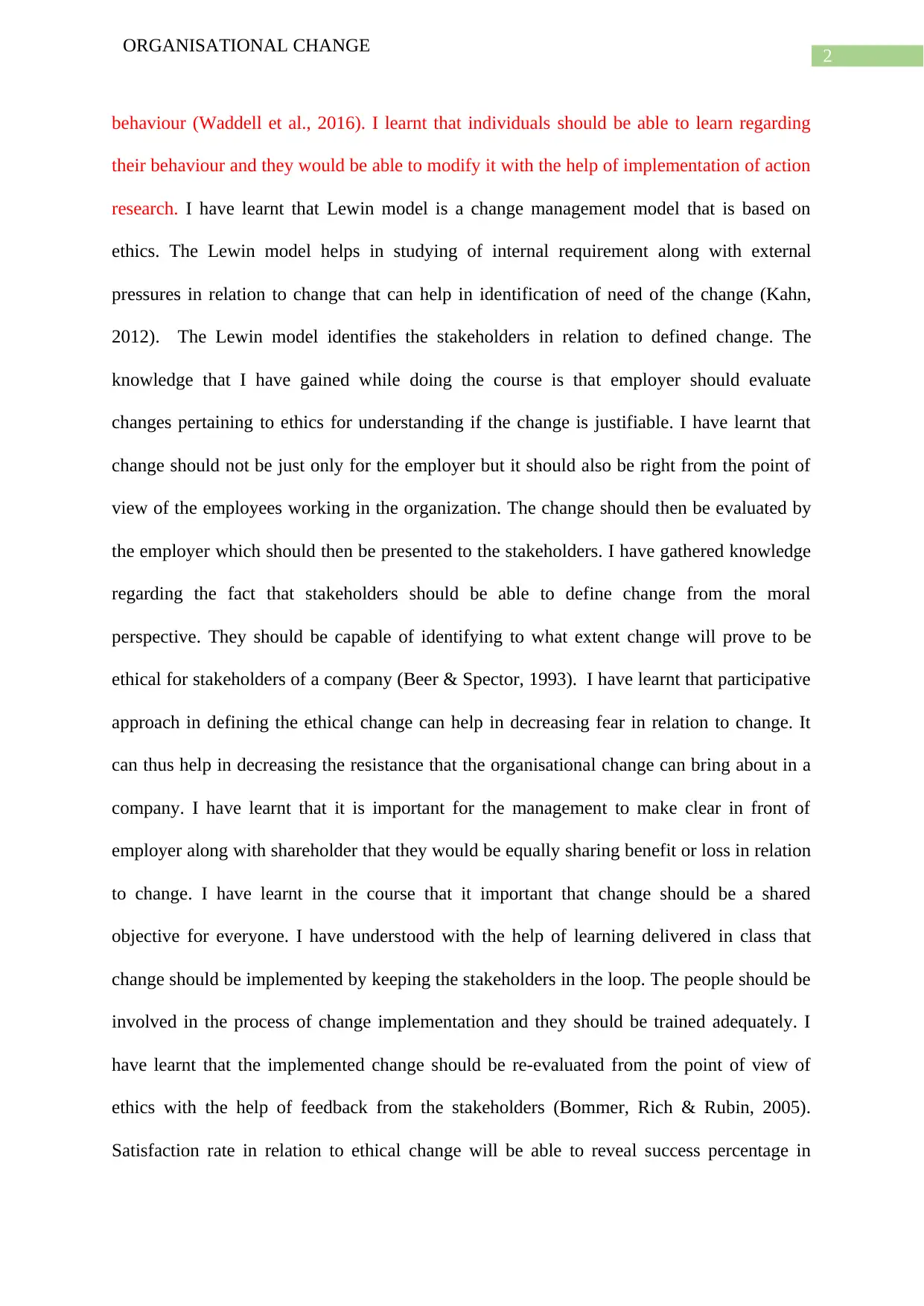
2
ORGANISATIONAL CHANGE
behaviour (Waddell et al., 2016). I learnt that individuals should be able to learn regarding
their behaviour and they would be able to modify it with the help of implementation of action
research. I have learnt that Lewin model is a change management model that is based on
ethics. The Lewin model helps in studying of internal requirement along with external
pressures in relation to change that can help in identification of need of the change (Kahn,
2012). The Lewin model identifies the stakeholders in relation to defined change. The
knowledge that I have gained while doing the course is that employer should evaluate
changes pertaining to ethics for understanding if the change is justifiable. I have learnt that
change should not be just only for the employer but it should also be right from the point of
view of the employees working in the organization. The change should then be evaluated by
the employer which should then be presented to the stakeholders. I have gathered knowledge
regarding the fact that stakeholders should be able to define change from the moral
perspective. They should be capable of identifying to what extent change will prove to be
ethical for stakeholders of a company (Beer & Spector, 1993). I have learnt that participative
approach in defining the ethical change can help in decreasing fear in relation to change. It
can thus help in decreasing the resistance that the organisational change can bring about in a
company. I have learnt that it is important for the management to make clear in front of
employer along with shareholder that they would be equally sharing benefit or loss in relation
to change. I have learnt in the course that it important that change should be a shared
objective for everyone. I have understood with the help of learning delivered in class that
change should be implemented by keeping the stakeholders in the loop. The people should be
involved in the process of change implementation and they should be trained adequately. I
have learnt that the implemented change should be re-evaluated from the point of view of
ethics with the help of feedback from the stakeholders (Bommer, Rich & Rubin, 2005).
Satisfaction rate in relation to ethical change will be able to reveal success percentage in
ORGANISATIONAL CHANGE
behaviour (Waddell et al., 2016). I learnt that individuals should be able to learn regarding
their behaviour and they would be able to modify it with the help of implementation of action
research. I have learnt that Lewin model is a change management model that is based on
ethics. The Lewin model helps in studying of internal requirement along with external
pressures in relation to change that can help in identification of need of the change (Kahn,
2012). The Lewin model identifies the stakeholders in relation to defined change. The
knowledge that I have gained while doing the course is that employer should evaluate
changes pertaining to ethics for understanding if the change is justifiable. I have learnt that
change should not be just only for the employer but it should also be right from the point of
view of the employees working in the organization. The change should then be evaluated by
the employer which should then be presented to the stakeholders. I have gathered knowledge
regarding the fact that stakeholders should be able to define change from the moral
perspective. They should be capable of identifying to what extent change will prove to be
ethical for stakeholders of a company (Beer & Spector, 1993). I have learnt that participative
approach in defining the ethical change can help in decreasing fear in relation to change. It
can thus help in decreasing the resistance that the organisational change can bring about in a
company. I have learnt that it is important for the management to make clear in front of
employer along with shareholder that they would be equally sharing benefit or loss in relation
to change. I have learnt in the course that it important that change should be a shared
objective for everyone. I have understood with the help of learning delivered in class that
change should be implemented by keeping the stakeholders in the loop. The people should be
involved in the process of change implementation and they should be trained adequately. I
have learnt that the implemented change should be re-evaluated from the point of view of
ethics with the help of feedback from the stakeholders (Bommer, Rich & Rubin, 2005).
Satisfaction rate in relation to ethical change will be able to reveal success percentage in
⊘ This is a preview!⊘
Do you want full access?
Subscribe today to unlock all pages.

Trusted by 1+ million students worldwide
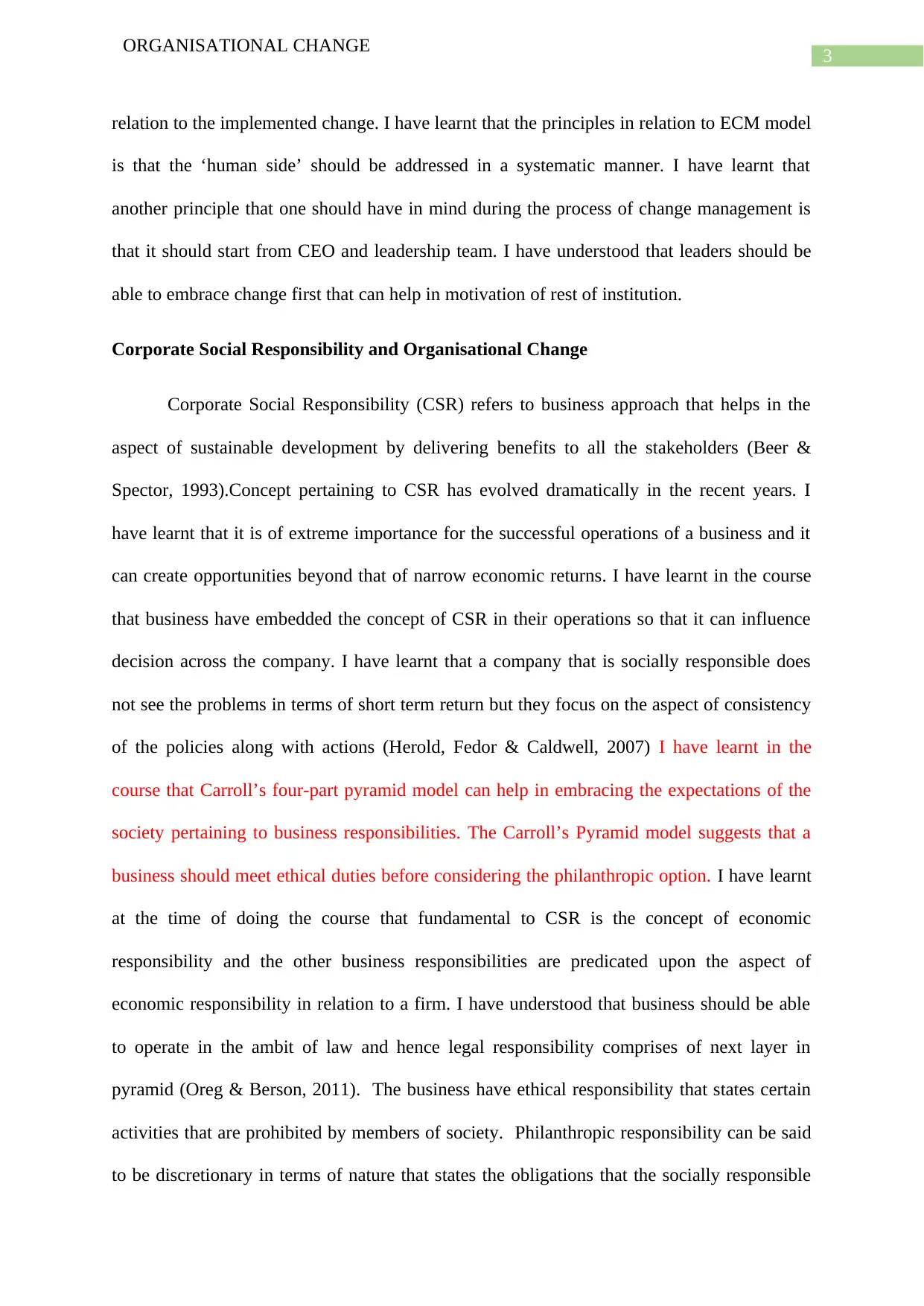
3
ORGANISATIONAL CHANGE
relation to the implemented change. I have learnt that the principles in relation to ECM model
is that the ‘human side’ should be addressed in a systematic manner. I have learnt that
another principle that one should have in mind during the process of change management is
that it should start from CEO and leadership team. I have understood that leaders should be
able to embrace change first that can help in motivation of rest of institution.
Corporate Social Responsibility and Organisational Change
Corporate Social Responsibility (CSR) refers to business approach that helps in the
aspect of sustainable development by delivering benefits to all the stakeholders (Beer &
Spector, 1993).Concept pertaining to CSR has evolved dramatically in the recent years. I
have learnt that it is of extreme importance for the successful operations of a business and it
can create opportunities beyond that of narrow economic returns. I have learnt in the course
that business have embedded the concept of CSR in their operations so that it can influence
decision across the company. I have learnt that a company that is socially responsible does
not see the problems in terms of short term return but they focus on the aspect of consistency
of the policies along with actions (Herold, Fedor & Caldwell, 2007) I have learnt in the
course that Carroll’s four-part pyramid model can help in embracing the expectations of the
society pertaining to business responsibilities. The Carroll’s Pyramid model suggests that a
business should meet ethical duties before considering the philanthropic option. I have learnt
at the time of doing the course that fundamental to CSR is the concept of economic
responsibility and the other business responsibilities are predicated upon the aspect of
economic responsibility in relation to a firm. I have understood that business should be able
to operate in the ambit of law and hence legal responsibility comprises of next layer in
pyramid (Oreg & Berson, 2011). The business have ethical responsibility that states certain
activities that are prohibited by members of society. Philanthropic responsibility can be said
to be discretionary in terms of nature that states the obligations that the socially responsible
ORGANISATIONAL CHANGE
relation to the implemented change. I have learnt that the principles in relation to ECM model
is that the ‘human side’ should be addressed in a systematic manner. I have learnt that
another principle that one should have in mind during the process of change management is
that it should start from CEO and leadership team. I have understood that leaders should be
able to embrace change first that can help in motivation of rest of institution.
Corporate Social Responsibility and Organisational Change
Corporate Social Responsibility (CSR) refers to business approach that helps in the
aspect of sustainable development by delivering benefits to all the stakeholders (Beer &
Spector, 1993).Concept pertaining to CSR has evolved dramatically in the recent years. I
have learnt that it is of extreme importance for the successful operations of a business and it
can create opportunities beyond that of narrow economic returns. I have learnt in the course
that business have embedded the concept of CSR in their operations so that it can influence
decision across the company. I have learnt that a company that is socially responsible does
not see the problems in terms of short term return but they focus on the aspect of consistency
of the policies along with actions (Herold, Fedor & Caldwell, 2007) I have learnt in the
course that Carroll’s four-part pyramid model can help in embracing the expectations of the
society pertaining to business responsibilities. The Carroll’s Pyramid model suggests that a
business should meet ethical duties before considering the philanthropic option. I have learnt
at the time of doing the course that fundamental to CSR is the concept of economic
responsibility and the other business responsibilities are predicated upon the aspect of
economic responsibility in relation to a firm. I have understood that business should be able
to operate in the ambit of law and hence legal responsibility comprises of next layer in
pyramid (Oreg & Berson, 2011). The business have ethical responsibility that states certain
activities that are prohibited by members of society. Philanthropic responsibility can be said
to be discretionary in terms of nature that states the obligations that the socially responsible
Paraphrase This Document
Need a fresh take? Get an instant paraphrase of this document with our AI Paraphraser
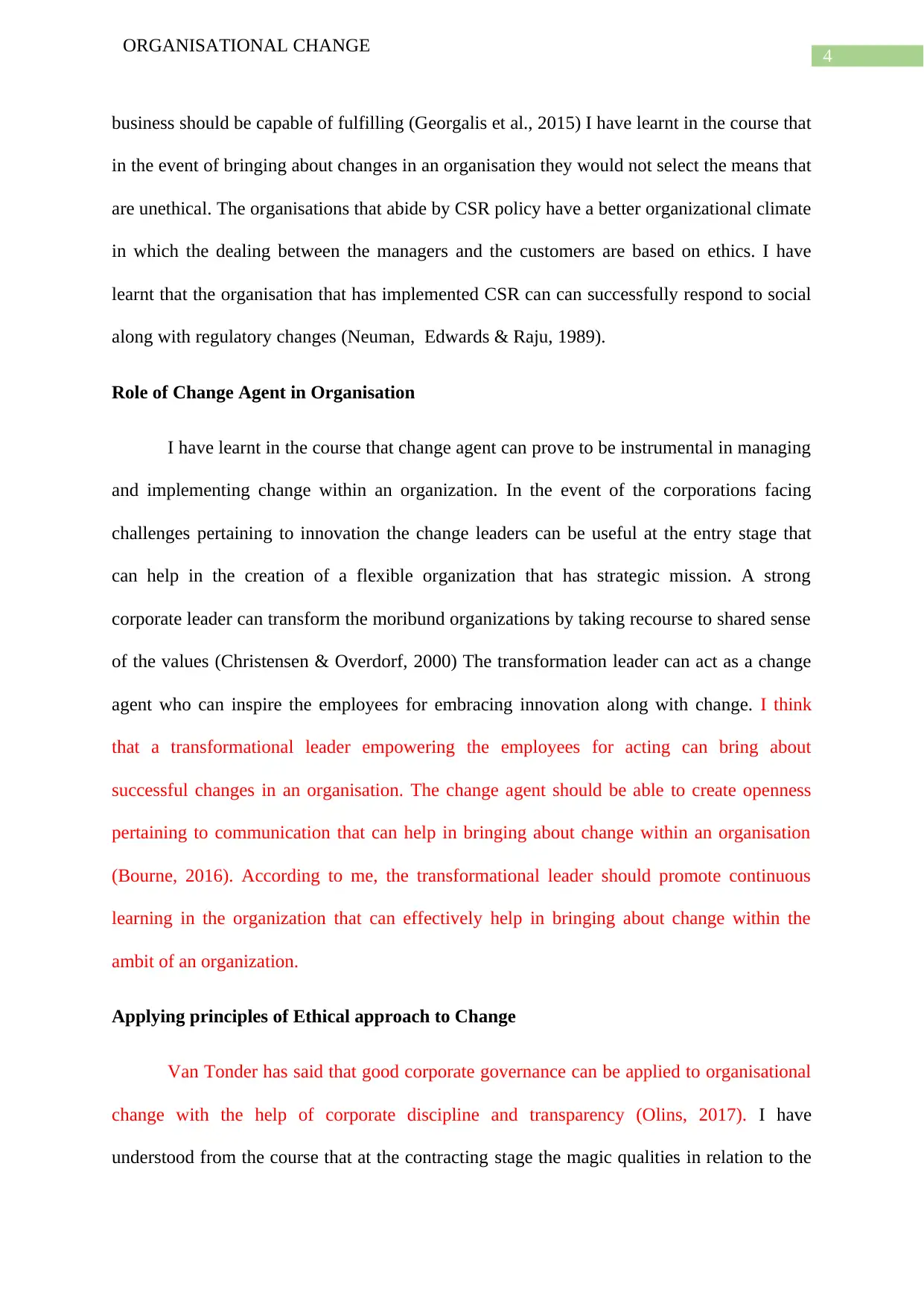
4
ORGANISATIONAL CHANGE
business should be capable of fulfilling (Georgalis et al., 2015) I have learnt in the course that
in the event of bringing about changes in an organisation they would not select the means that
are unethical. The organisations that abide by CSR policy have a better organizational climate
in which the dealing between the managers and the customers are based on ethics. I have
learnt that the organisation that has implemented CSR can can successfully respond to social
along with regulatory changes (Neuman, Edwards & Raju, 1989).
Role of Change Agent in Organisation
I have learnt in the course that change agent can prove to be instrumental in managing
and implementing change within an organization. In the event of the corporations facing
challenges pertaining to innovation the change leaders can be useful at the entry stage that
can help in the creation of a flexible organization that has strategic mission. A strong
corporate leader can transform the moribund organizations by taking recourse to shared sense
of the values (Christensen & Overdorf, 2000) The transformation leader can act as a change
agent who can inspire the employees for embracing innovation along with change. I think
that a transformational leader empowering the employees for acting can bring about
successful changes in an organisation. The change agent should be able to create openness
pertaining to communication that can help in bringing about change within an organisation
(Bourne, 2016). According to me, the transformational leader should promote continuous
learning in the organization that can effectively help in bringing about change within the
ambit of an organization.
Applying principles of Ethical approach to Change
Van Tonder has said that good corporate governance can be applied to organisational
change with the help of corporate discipline and transparency (Olins, 2017). I have
understood from the course that at the contracting stage the magic qualities in relation to the
ORGANISATIONAL CHANGE
business should be capable of fulfilling (Georgalis et al., 2015) I have learnt in the course that
in the event of bringing about changes in an organisation they would not select the means that
are unethical. The organisations that abide by CSR policy have a better organizational climate
in which the dealing between the managers and the customers are based on ethics. I have
learnt that the organisation that has implemented CSR can can successfully respond to social
along with regulatory changes (Neuman, Edwards & Raju, 1989).
Role of Change Agent in Organisation
I have learnt in the course that change agent can prove to be instrumental in managing
and implementing change within an organization. In the event of the corporations facing
challenges pertaining to innovation the change leaders can be useful at the entry stage that
can help in the creation of a flexible organization that has strategic mission. A strong
corporate leader can transform the moribund organizations by taking recourse to shared sense
of the values (Christensen & Overdorf, 2000) The transformation leader can act as a change
agent who can inspire the employees for embracing innovation along with change. I think
that a transformational leader empowering the employees for acting can bring about
successful changes in an organisation. The change agent should be able to create openness
pertaining to communication that can help in bringing about change within an organisation
(Bourne, 2016). According to me, the transformational leader should promote continuous
learning in the organization that can effectively help in bringing about change within the
ambit of an organization.
Applying principles of Ethical approach to Change
Van Tonder has said that good corporate governance can be applied to organisational
change with the help of corporate discipline and transparency (Olins, 2017). I have
understood from the course that at the contracting stage the magic qualities in relation to the
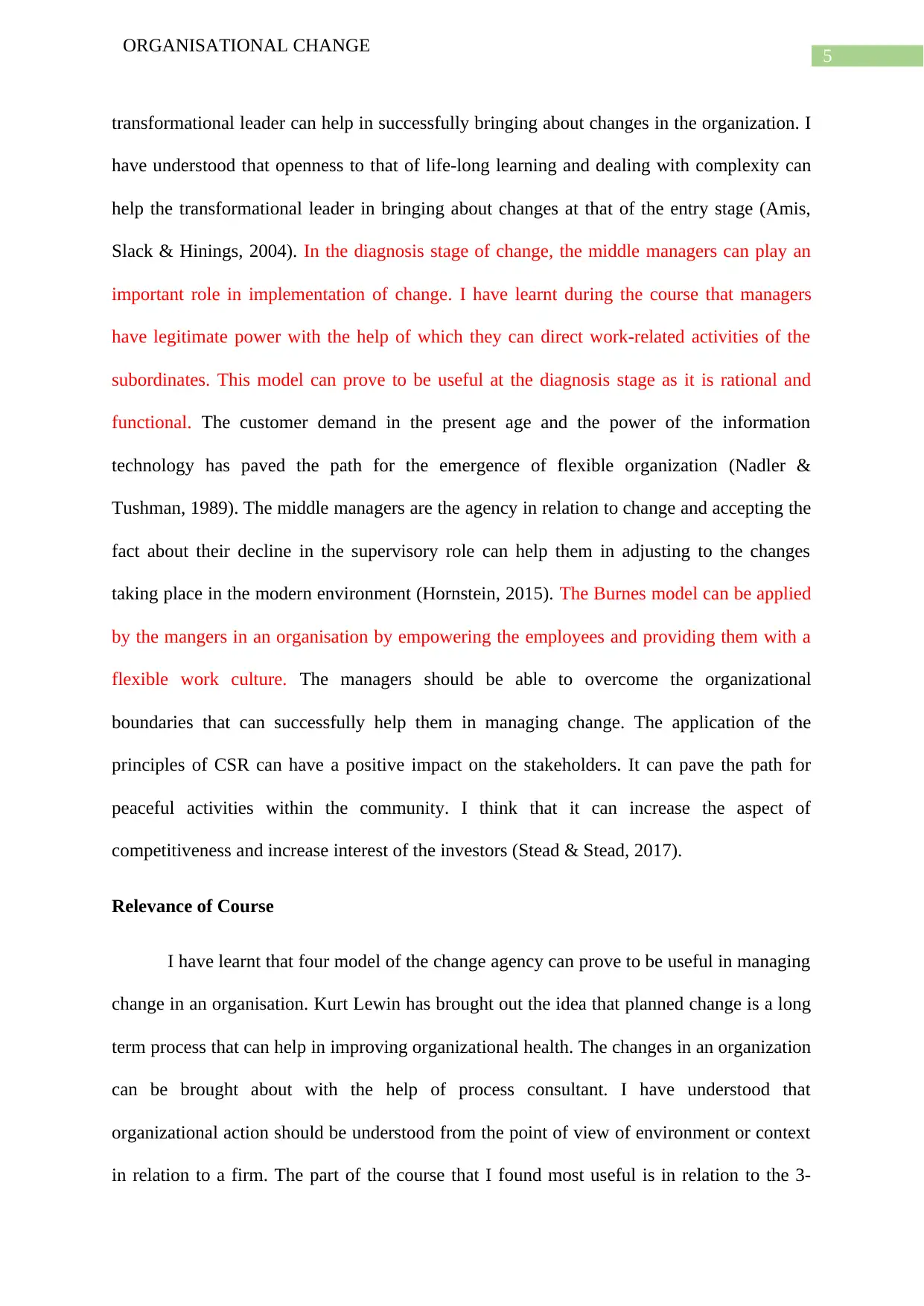
5
ORGANISATIONAL CHANGE
transformational leader can help in successfully bringing about changes in the organization. I
have understood that openness to that of life-long learning and dealing with complexity can
help the transformational leader in bringing about changes at that of the entry stage (Amis,
Slack & Hinings, 2004). In the diagnosis stage of change, the middle managers can play an
important role in implementation of change. I have learnt during the course that managers
have legitimate power with the help of which they can direct work-related activities of the
subordinates. This model can prove to be useful at the diagnosis stage as it is rational and
functional. The customer demand in the present age and the power of the information
technology has paved the path for the emergence of flexible organization (Nadler &
Tushman, 1989). The middle managers are the agency in relation to change and accepting the
fact about their decline in the supervisory role can help them in adjusting to the changes
taking place in the modern environment (Hornstein, 2015). The Burnes model can be applied
by the mangers in an organisation by empowering the employees and providing them with a
flexible work culture. The managers should be able to overcome the organizational
boundaries that can successfully help them in managing change. The application of the
principles of CSR can have a positive impact on the stakeholders. It can pave the path for
peaceful activities within the community. I think that it can increase the aspect of
competitiveness and increase interest of the investors (Stead & Stead, 2017).
Relevance of Course
I have learnt that four model of the change agency can prove to be useful in managing
change in an organisation. Kurt Lewin has brought out the idea that planned change is a long
term process that can help in improving organizational health. The changes in an organization
can be brought about with the help of process consultant. I have understood that
organizational action should be understood from the point of view of environment or context
in relation to a firm. The part of the course that I found most useful is in relation to the 3-
ORGANISATIONAL CHANGE
transformational leader can help in successfully bringing about changes in the organization. I
have understood that openness to that of life-long learning and dealing with complexity can
help the transformational leader in bringing about changes at that of the entry stage (Amis,
Slack & Hinings, 2004). In the diagnosis stage of change, the middle managers can play an
important role in implementation of change. I have learnt during the course that managers
have legitimate power with the help of which they can direct work-related activities of the
subordinates. This model can prove to be useful at the diagnosis stage as it is rational and
functional. The customer demand in the present age and the power of the information
technology has paved the path for the emergence of flexible organization (Nadler &
Tushman, 1989). The middle managers are the agency in relation to change and accepting the
fact about their decline in the supervisory role can help them in adjusting to the changes
taking place in the modern environment (Hornstein, 2015). The Burnes model can be applied
by the mangers in an organisation by empowering the employees and providing them with a
flexible work culture. The managers should be able to overcome the organizational
boundaries that can successfully help them in managing change. The application of the
principles of CSR can have a positive impact on the stakeholders. It can pave the path for
peaceful activities within the community. I think that it can increase the aspect of
competitiveness and increase interest of the investors (Stead & Stead, 2017).
Relevance of Course
I have learnt that four model of the change agency can prove to be useful in managing
change in an organisation. Kurt Lewin has brought out the idea that planned change is a long
term process that can help in improving organizational health. The changes in an organization
can be brought about with the help of process consultant. I have understood that
organizational action should be understood from the point of view of environment or context
in relation to a firm. The part of the course that I found most useful is in relation to the 3-
⊘ This is a preview!⊘
Do you want full access?
Subscribe today to unlock all pages.

Trusted by 1+ million students worldwide
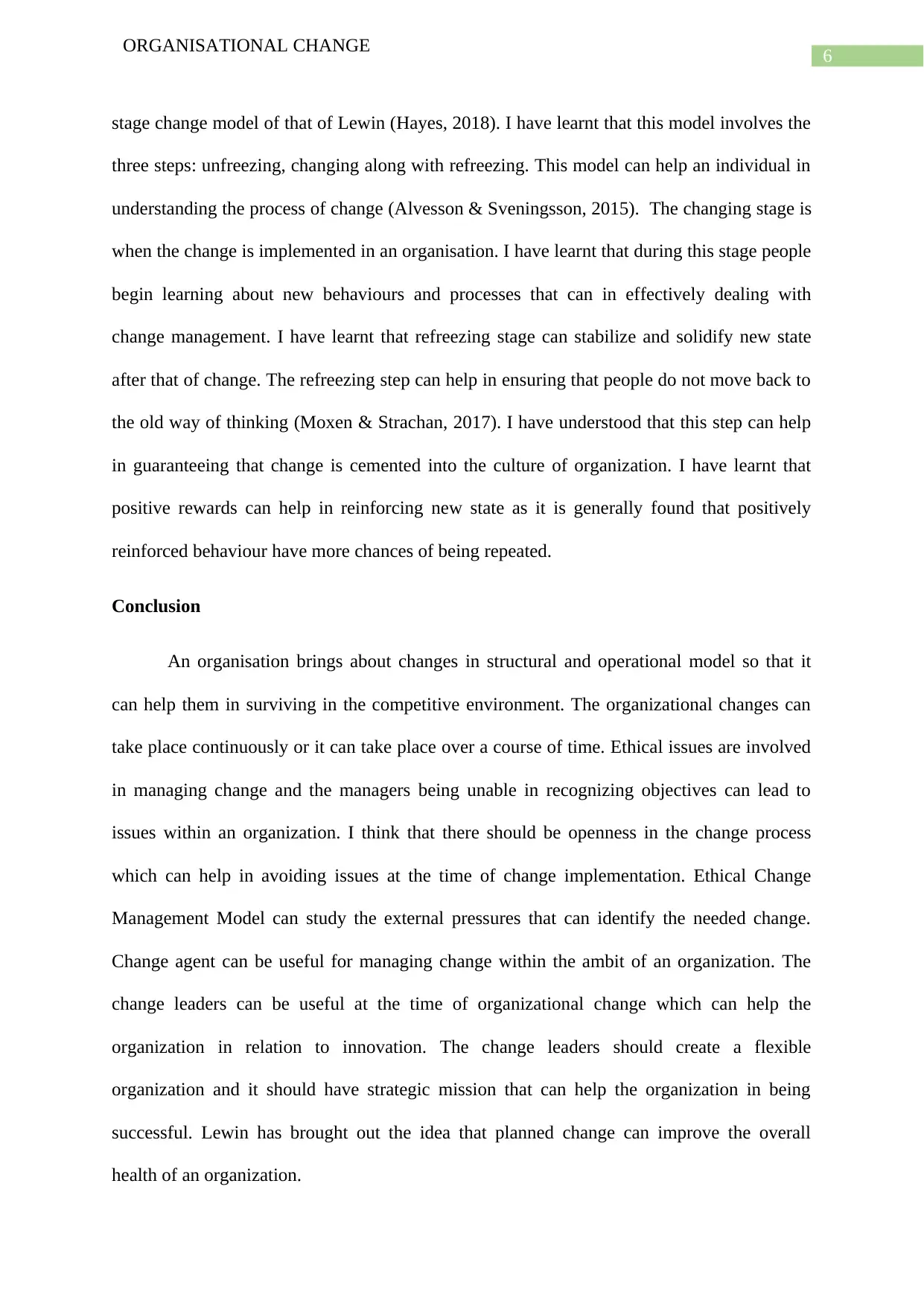
6
ORGANISATIONAL CHANGE
stage change model of that of Lewin (Hayes, 2018). I have learnt that this model involves the
three steps: unfreezing, changing along with refreezing. This model can help an individual in
understanding the process of change (Alvesson & Sveningsson, 2015). The changing stage is
when the change is implemented in an organisation. I have learnt that during this stage people
begin learning about new behaviours and processes that can in effectively dealing with
change management. I have learnt that refreezing stage can stabilize and solidify new state
after that of change. The refreezing step can help in ensuring that people do not move back to
the old way of thinking (Moxen & Strachan, 2017). I have understood that this step can help
in guaranteeing that change is cemented into the culture of organization. I have learnt that
positive rewards can help in reinforcing new state as it is generally found that positively
reinforced behaviour have more chances of being repeated.
Conclusion
An organisation brings about changes in structural and operational model so that it
can help them in surviving in the competitive environment. The organizational changes can
take place continuously or it can take place over a course of time. Ethical issues are involved
in managing change and the managers being unable in recognizing objectives can lead to
issues within an organization. I think that there should be openness in the change process
which can help in avoiding issues at the time of change implementation. Ethical Change
Management Model can study the external pressures that can identify the needed change.
Change agent can be useful for managing change within the ambit of an organization. The
change leaders can be useful at the time of organizational change which can help the
organization in relation to innovation. The change leaders should create a flexible
organization and it should have strategic mission that can help the organization in being
successful. Lewin has brought out the idea that planned change can improve the overall
health of an organization.
ORGANISATIONAL CHANGE
stage change model of that of Lewin (Hayes, 2018). I have learnt that this model involves the
three steps: unfreezing, changing along with refreezing. This model can help an individual in
understanding the process of change (Alvesson & Sveningsson, 2015). The changing stage is
when the change is implemented in an organisation. I have learnt that during this stage people
begin learning about new behaviours and processes that can in effectively dealing with
change management. I have learnt that refreezing stage can stabilize and solidify new state
after that of change. The refreezing step can help in ensuring that people do not move back to
the old way of thinking (Moxen & Strachan, 2017). I have understood that this step can help
in guaranteeing that change is cemented into the culture of organization. I have learnt that
positive rewards can help in reinforcing new state as it is generally found that positively
reinforced behaviour have more chances of being repeated.
Conclusion
An organisation brings about changes in structural and operational model so that it
can help them in surviving in the competitive environment. The organizational changes can
take place continuously or it can take place over a course of time. Ethical issues are involved
in managing change and the managers being unable in recognizing objectives can lead to
issues within an organization. I think that there should be openness in the change process
which can help in avoiding issues at the time of change implementation. Ethical Change
Management Model can study the external pressures that can identify the needed change.
Change agent can be useful for managing change within the ambit of an organization. The
change leaders can be useful at the time of organizational change which can help the
organization in relation to innovation. The change leaders should create a flexible
organization and it should have strategic mission that can help the organization in being
successful. Lewin has brought out the idea that planned change can improve the overall
health of an organization.
Paraphrase This Document
Need a fresh take? Get an instant paraphrase of this document with our AI Paraphraser
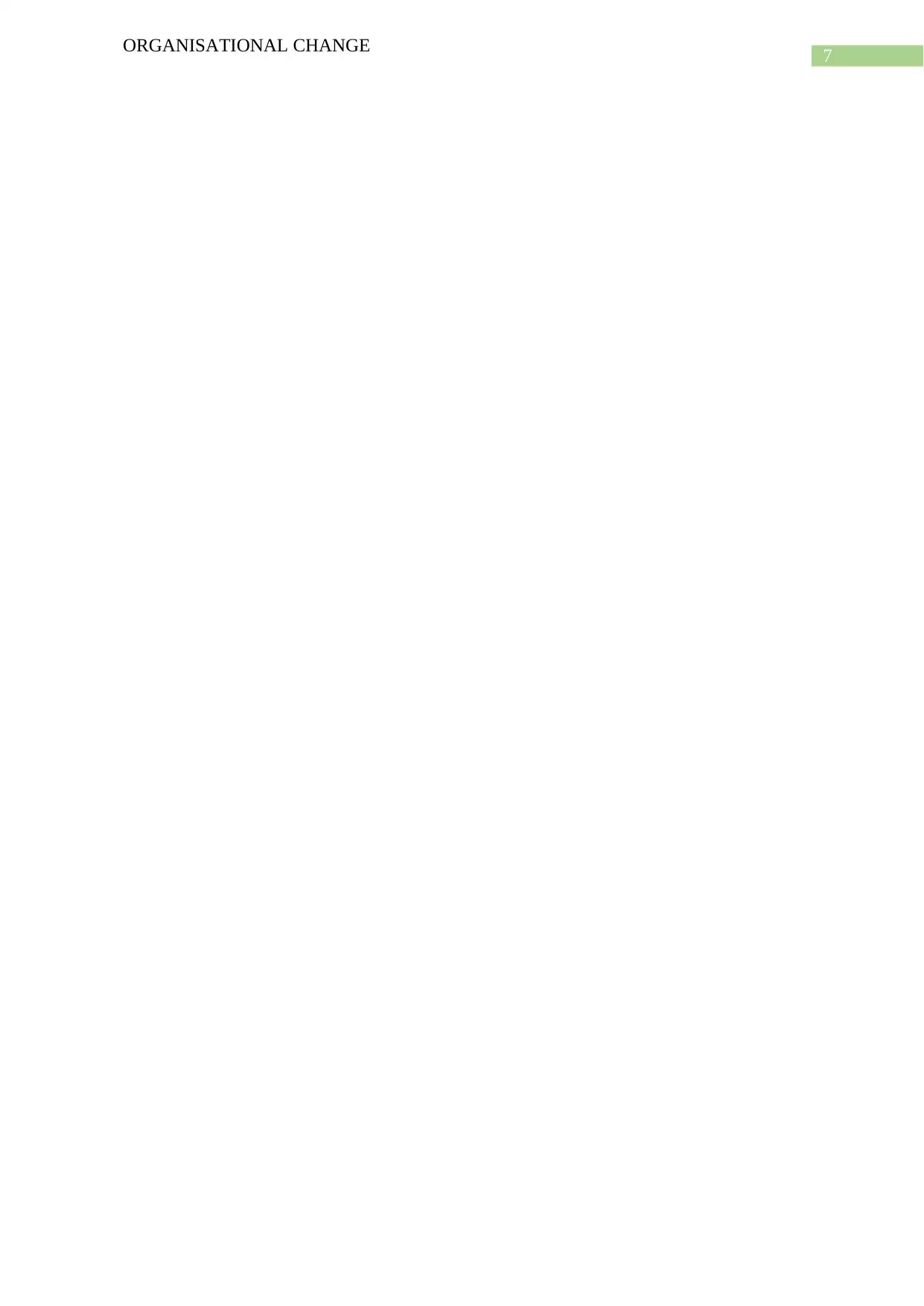
7
ORGANISATIONAL CHANGE
ORGANISATIONAL CHANGE
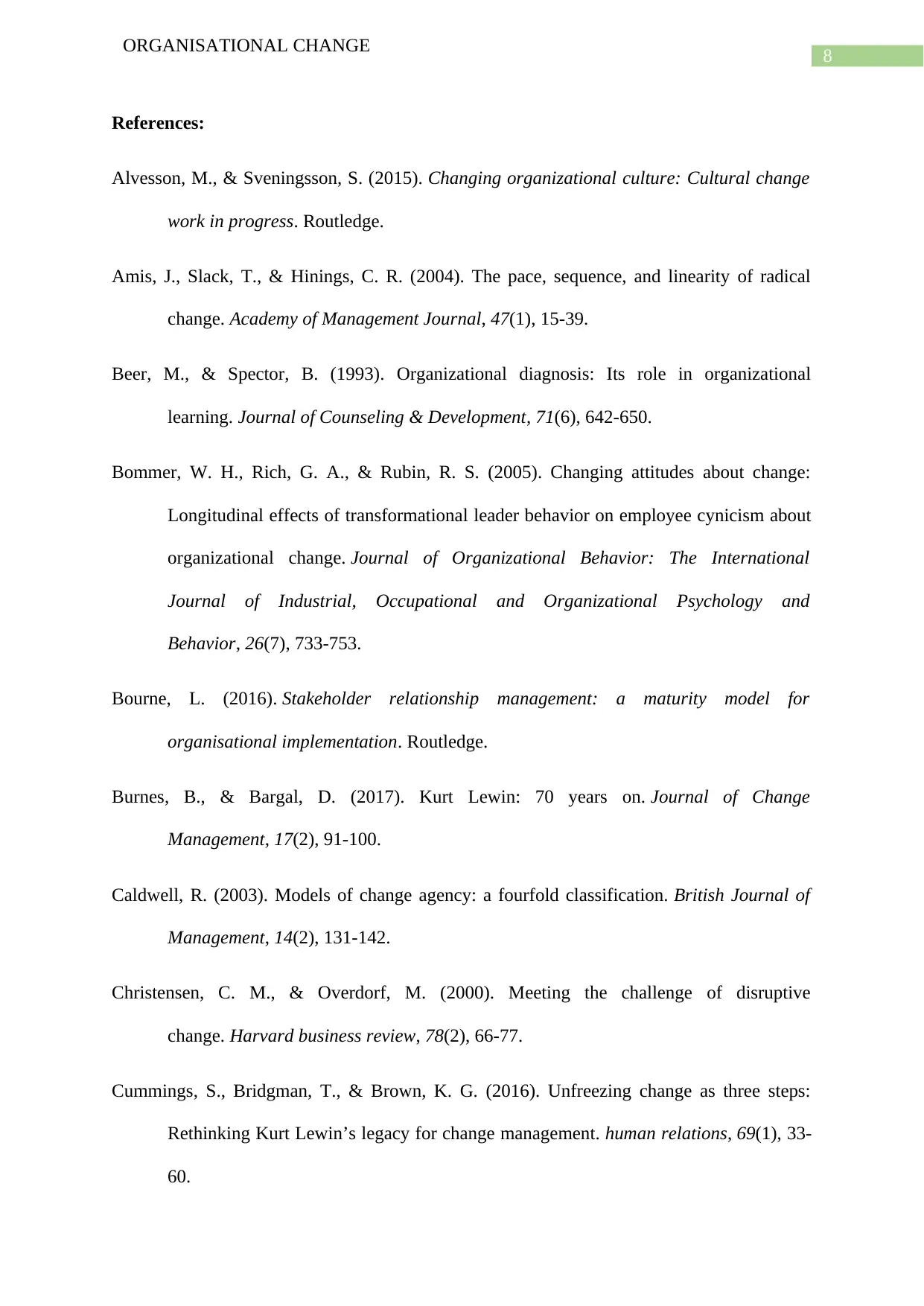
8
ORGANISATIONAL CHANGE
References:
Alvesson, M., & Sveningsson, S. (2015). Changing organizational culture: Cultural change
work in progress. Routledge.
Amis, J., Slack, T., & Hinings, C. R. (2004). The pace, sequence, and linearity of radical
change. Academy of Management Journal, 47(1), 15-39.
Beer, M., & Spector, B. (1993). Organizational diagnosis: Its role in organizational
learning. Journal of Counseling & Development, 71(6), 642-650.
Bommer, W. H., Rich, G. A., & Rubin, R. S. (2005). Changing attitudes about change:
Longitudinal effects of transformational leader behavior on employee cynicism about
organizational change. Journal of Organizational Behavior: The International
Journal of Industrial, Occupational and Organizational Psychology and
Behavior, 26(7), 733-753.
Bourne, L. (2016). Stakeholder relationship management: a maturity model for
organisational implementation. Routledge.
Burnes, B., & Bargal, D. (2017). Kurt Lewin: 70 years on. Journal of Change
Management, 17(2), 91-100.
Caldwell, R. (2003). Models of change agency: a fourfold classification. British Journal of
Management, 14(2), 131-142.
Christensen, C. M., & Overdorf, M. (2000). Meeting the challenge of disruptive
change. Harvard business review, 78(2), 66-77.
Cummings, S., Bridgman, T., & Brown, K. G. (2016). Unfreezing change as three steps:
Rethinking Kurt Lewin’s legacy for change management. human relations, 69(1), 33-
60.
ORGANISATIONAL CHANGE
References:
Alvesson, M., & Sveningsson, S. (2015). Changing organizational culture: Cultural change
work in progress. Routledge.
Amis, J., Slack, T., & Hinings, C. R. (2004). The pace, sequence, and linearity of radical
change. Academy of Management Journal, 47(1), 15-39.
Beer, M., & Spector, B. (1993). Organizational diagnosis: Its role in organizational
learning. Journal of Counseling & Development, 71(6), 642-650.
Bommer, W. H., Rich, G. A., & Rubin, R. S. (2005). Changing attitudes about change:
Longitudinal effects of transformational leader behavior on employee cynicism about
organizational change. Journal of Organizational Behavior: The International
Journal of Industrial, Occupational and Organizational Psychology and
Behavior, 26(7), 733-753.
Bourne, L. (2016). Stakeholder relationship management: a maturity model for
organisational implementation. Routledge.
Burnes, B., & Bargal, D. (2017). Kurt Lewin: 70 years on. Journal of Change
Management, 17(2), 91-100.
Caldwell, R. (2003). Models of change agency: a fourfold classification. British Journal of
Management, 14(2), 131-142.
Christensen, C. M., & Overdorf, M. (2000). Meeting the challenge of disruptive
change. Harvard business review, 78(2), 66-77.
Cummings, S., Bridgman, T., & Brown, K. G. (2016). Unfreezing change as three steps:
Rethinking Kurt Lewin’s legacy for change management. human relations, 69(1), 33-
60.
⊘ This is a preview!⊘
Do you want full access?
Subscribe today to unlock all pages.

Trusted by 1+ million students worldwide
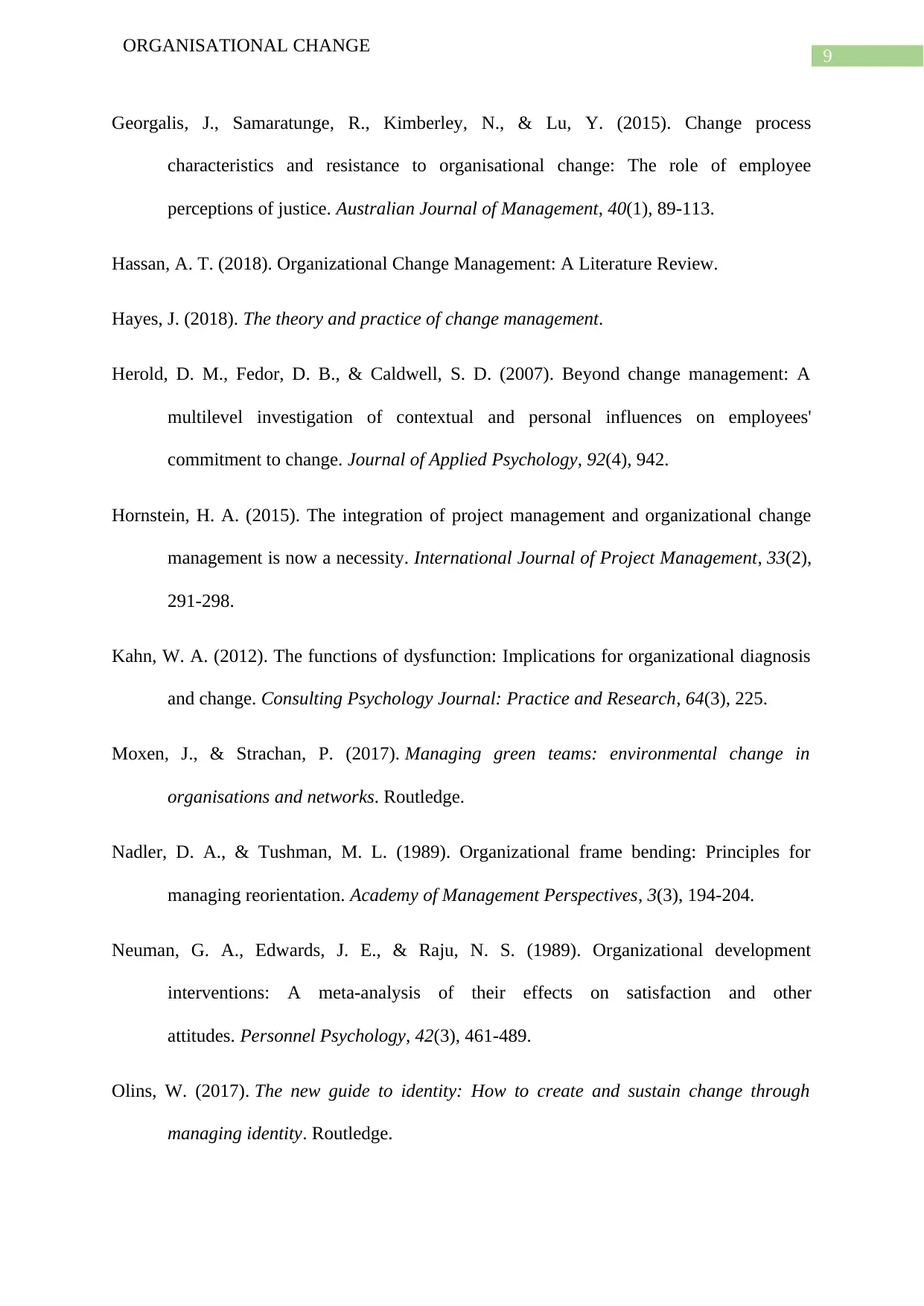
9
ORGANISATIONAL CHANGE
Georgalis, J., Samaratunge, R., Kimberley, N., & Lu, Y. (2015). Change process
characteristics and resistance to organisational change: The role of employee
perceptions of justice. Australian Journal of Management, 40(1), 89-113.
Hassan, A. T. (2018). Organizational Change Management: A Literature Review.
Hayes, J. (2018). The theory and practice of change management.
Herold, D. M., Fedor, D. B., & Caldwell, S. D. (2007). Beyond change management: A
multilevel investigation of contextual and personal influences on employees'
commitment to change. Journal of Applied Psychology, 92(4), 942.
Hornstein, H. A. (2015). The integration of project management and organizational change
management is now a necessity. International Journal of Project Management, 33(2),
291-298.
Kahn, W. A. (2012). The functions of dysfunction: Implications for organizational diagnosis
and change. Consulting Psychology Journal: Practice and Research, 64(3), 225.
Moxen, J., & Strachan, P. (2017). Managing green teams: environmental change in
organisations and networks. Routledge.
Nadler, D. A., & Tushman, M. L. (1989). Organizational frame bending: Principles for
managing reorientation. Academy of Management Perspectives, 3(3), 194-204.
Neuman, G. A., Edwards, J. E., & Raju, N. S. (1989). Organizational development
interventions: A meta‐analysis of their effects on satisfaction and other
attitudes. Personnel Psychology, 42(3), 461-489.
Olins, W. (2017). The new guide to identity: How to create and sustain change through
managing identity. Routledge.
ORGANISATIONAL CHANGE
Georgalis, J., Samaratunge, R., Kimberley, N., & Lu, Y. (2015). Change process
characteristics and resistance to organisational change: The role of employee
perceptions of justice. Australian Journal of Management, 40(1), 89-113.
Hassan, A. T. (2018). Organizational Change Management: A Literature Review.
Hayes, J. (2018). The theory and practice of change management.
Herold, D. M., Fedor, D. B., & Caldwell, S. D. (2007). Beyond change management: A
multilevel investigation of contextual and personal influences on employees'
commitment to change. Journal of Applied Psychology, 92(4), 942.
Hornstein, H. A. (2015). The integration of project management and organizational change
management is now a necessity. International Journal of Project Management, 33(2),
291-298.
Kahn, W. A. (2012). The functions of dysfunction: Implications for organizational diagnosis
and change. Consulting Psychology Journal: Practice and Research, 64(3), 225.
Moxen, J., & Strachan, P. (2017). Managing green teams: environmental change in
organisations and networks. Routledge.
Nadler, D. A., & Tushman, M. L. (1989). Organizational frame bending: Principles for
managing reorientation. Academy of Management Perspectives, 3(3), 194-204.
Neuman, G. A., Edwards, J. E., & Raju, N. S. (1989). Organizational development
interventions: A meta‐analysis of their effects on satisfaction and other
attitudes. Personnel Psychology, 42(3), 461-489.
Olins, W. (2017). The new guide to identity: How to create and sustain change through
managing identity. Routledge.
Paraphrase This Document
Need a fresh take? Get an instant paraphrase of this document with our AI Paraphraser
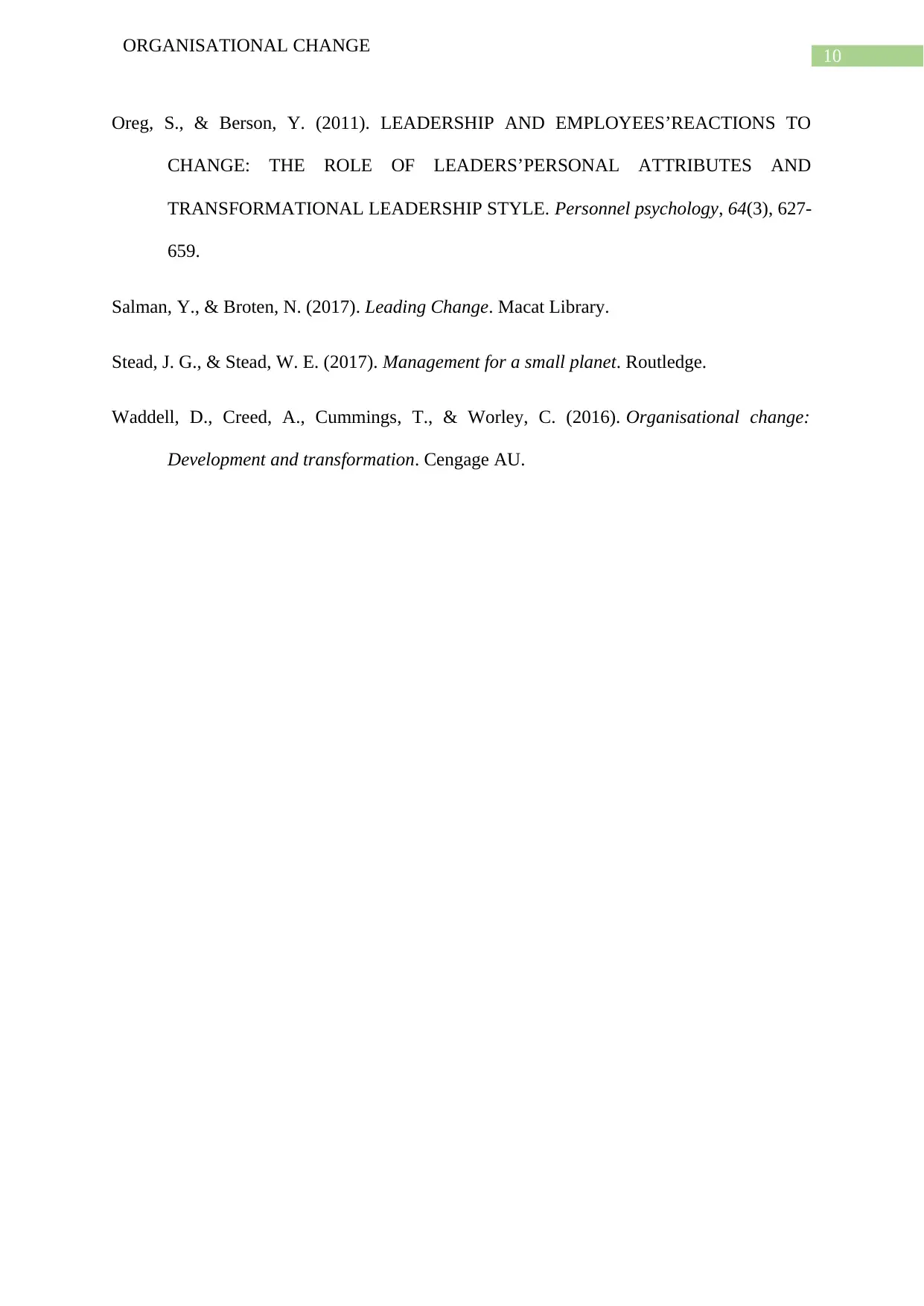
10
ORGANISATIONAL CHANGE
Oreg, S., & Berson, Y. (2011). LEADERSHIP AND EMPLOYEES’REACTIONS TO
CHANGE: THE ROLE OF LEADERS’PERSONAL ATTRIBUTES AND
TRANSFORMATIONAL LEADERSHIP STYLE. Personnel psychology, 64(3), 627-
659.
Salman, Y., & Broten, N. (2017). Leading Change. Macat Library.
Stead, J. G., & Stead, W. E. (2017). Management for a small planet. Routledge.
Waddell, D., Creed, A., Cummings, T., & Worley, C. (2016). Organisational change:
Development and transformation. Cengage AU.
ORGANISATIONAL CHANGE
Oreg, S., & Berson, Y. (2011). LEADERSHIP AND EMPLOYEES’REACTIONS TO
CHANGE: THE ROLE OF LEADERS’PERSONAL ATTRIBUTES AND
TRANSFORMATIONAL LEADERSHIP STYLE. Personnel psychology, 64(3), 627-
659.
Salman, Y., & Broten, N. (2017). Leading Change. Macat Library.
Stead, J. G., & Stead, W. E. (2017). Management for a small planet. Routledge.
Waddell, D., Creed, A., Cummings, T., & Worley, C. (2016). Organisational change:
Development and transformation. Cengage AU.
1 out of 11
Related Documents
Your All-in-One AI-Powered Toolkit for Academic Success.
+13062052269
info@desklib.com
Available 24*7 on WhatsApp / Email
![[object Object]](/_next/static/media/star-bottom.7253800d.svg)
Unlock your academic potential
Copyright © 2020–2025 A2Z Services. All Rights Reserved. Developed and managed by ZUCOL.





